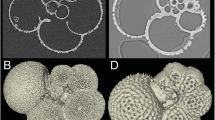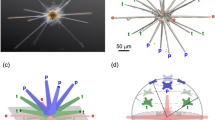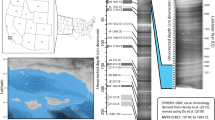Abstract
Foraminifera are separated systematically at the subordinal and suprafamilial level on the basis of their wall ultrastructure1, yet those elements of the walls are near or at the resolution of the optical microscope2. To delineate those elements we have initiated a comprehensive study of the test ultrastructure of calcareous Foraminifera, utilising high voltage transmission electron microscopy (HVTEM) of specimens thinned by ion bombardment3,4. We find certain ultrastructural characteristics to be common both to all Foraminifera studied and to all other comparison biological carbonate: for example, organic inclusions are found within and on the boundaries between the crystals of miliolid, fusulinid and rotaliid foraminiferal tests, bivalve shells, coral skeletons and human teeth. Other characteristics are typical of a particular host mineral, but independent of phyletic affinities: for example, the size, shape and abundance of inclusions are different in aragonite crystals from calcite crystals. Still other characteristics are diagnostic of certain groups: for example, crystal sizes and shapes are definitely different for the various suborders of Foraminifera. These ultrastructural characteristics should lead to a better understanding of the relationships between groups of Foraminifera, and to a better understanding of the biological calcification process in general. But more immediately, they provide powerful criteria for the evaluation of ultrastructural modification during and after fossilisation, especially for extinct forms such as the fusulinid Foraminifera.
This is a preview of subscription content, access via your institution
Access options
Subscribe to this journal
Receive 51 print issues and online access
$199.00 per year
only $3.90 per issue
Buy this article
- Purchase on Springer Link
- Instant access to full article PDF
Prices may be subject to local taxes which are calculated during checkout
Similar content being viewed by others
References
Loeblich, A. R. Jr & Tappan, H. Treatise on Invert. Palaeontol., Protista 2, Part C (1964).
Lipps, J. H. A. Rev. Microbiol. 27, 471 (1973).
Conger, S. D. & Green, H. W. J. Paleont. 50, 795 (1976).
Conger, S. D., Green, H. W. & Lipps, J. H. J. Foram. Res. 7, 278 (1977).
Cushman, J. A. & Waters, J. A. Univ. Texas Bull. No. 3019, 22 (1930).
Dunbar, C. O. & Condra, G. E. Bull. Nebraska Geol. Surv. Ser. 2, no. 2 (1927).
Green, H. W., Griggs, D. T. & Christie, J. M. in Experimental and Natural Rock Deformation (ed. Paulitsch, P.) 272 (Springer, Berlin, 1970).
Green, H. W. in Electron Microscopy in Mineralogy (eds Wenk, H.R. et al.) 443 (Springer, Berlin, 1976).
Schmidt, S. M., Boland, J. N. & Paterson, M. S. Tectonophysics 43, 257 (1977).
Champness, P. E. & Lorimer, G. W. in Electron Microscopy in Mineralogy (eds Wenk, H.-R. et al.) 174 (Springer, Berlin, 1976).
Towe, K. M. & Hemleben, C. Geology 4, 337 (1976).
Author information
Authors and Affiliations
Rights and permissions
About this article
Cite this article
Green, H., Lipps, J. & Showers, W. Test ultrastructure of fusulinid Foraminifera. Nature 283, 853–855 (1980). https://doi.org/10.1038/283853a0
Received:
Accepted:
Issue Date:
DOI: https://doi.org/10.1038/283853a0
This article is cited by
-
Unlocking the biomineralization style and affinity of Paleozoic fusulinid foraminifera
Scientific Reports (2017)
-
A three- and two-dimensional documentation of structural elements in schwagerinids (superfamily Fusulinoidea) exemplified by silicified material from the Upper Carboniferous of the Carnic Alps (Austria/Italy): a comparison with verbeekinoideans and alveolinids
Facies (2005)
-
Biostratigraphical correlation of late carboniferous (Kasimovian) sections in the Carnic Alps (Austria/Italy): Integrated paleontological data, facies, and discussion
Facies (2000)
Comments
By submitting a comment you agree to abide by our Terms and Community Guidelines. If you find something abusive or that does not comply with our terms or guidelines please flag it as inappropriate.



